PAINTING: The first hour will be devoted to comparisons between paintings of the Romantic era—essentially the earlier 19th century, with extensions before and after. [In the actual class, the two pictures below will be shown with different comparisons.]



FILM: In the second hour, we will compare ways that film directors have created the atmosphere called for in subjects from, or beloved to, the Romantic era: Macbeth, Frankenstein, and The Turn of the Screw.
ART: The art discussed (or intended to be discussed) in the first hour of class are below.
For the films in the second hour, click here.
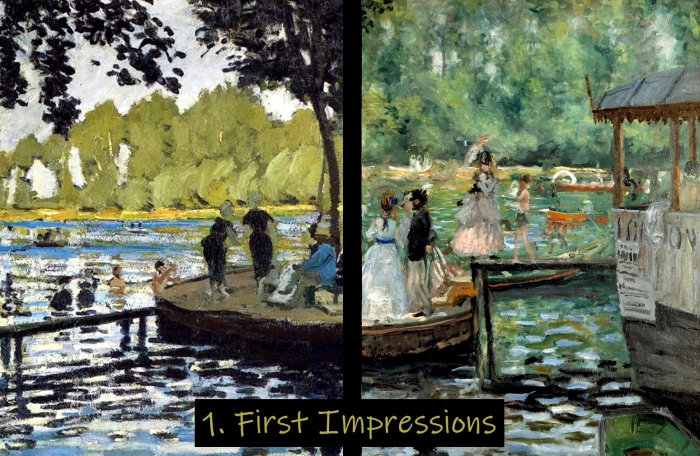
Delacroix: Two Tigers Playing (1831, NY Met)
COMPARISON 1



Some questions: How accessible is the site of each picture? Which situation is the more usual? What are the people doing in each? Is each painter present at the spot? What emotion does each convey, and do you think this is intentional?
Some facts: De Loutherbourg was an Alsatian painter who settled in London in his thirties. He specialized in landscapes and seascapes that showed the power of nature, the Sublime, intended to inspire intense feelings of awe and even terror. The Sublime was one of the prime sources of Romantic painting and verse, certainly affecting Turner's choice of subjects, though he was more objective in depicting what he saw, starting with his first visit to the continent in 1802.

Turner: The Devil’s Bridge, St Gotthard Pass (detail, 1803, Zürich)
Some questions: Same questions as before. How accessible? How unusual? Action of the figures? Emotion?
Some facts: The Devil's Bridge over the Schöllenen Gorge in the St Gotthard Pass between Switzerland and Italy has now been replaced by road and rail bridges, but it is still a crossing that must be made by anyone taking the route. Turner made many drawings and watercolors of it, from different angles, some of which he later worked up into paintings, and he was far from the only artist to do so.
COMPARISON 2



Some questions: What is the setting of each picture? How are the rocks used, and the sky? How would you describe the lighting of each? What is the purpose in each case?
Some facts: George Stubbs' interest in horses took several forms. As a portrait painter, he would depict the prize throughbreds of wealthy owners, just as though he were painting their estates or their wives. As a scientist, he kept a studio where he dissected horses in order to publish detailed plates of equine anatomy. And as a proto-Romantic, he was interested in what might be called the mythos of the horse, and the symbolism of encounters between two kinds of strength, such as this one.

Horse pictures by Vernet and Delacroix
Some questions: Both artists have chosen to paint horses rearing up; is the purpose the same in each case? What is the relation of the horses to their background? Does the medium (oil paint versus watercolor) make any difference?
Some facts: The race of riderless horses, la mossa, in the Piazza del Popolo in Rome used to be an annual event. Goethe called it "one of the finest sights that can be seen anywhere in the world." Géricault painted it in 1818, and his friend Vernet followed with a more flamboyant style; this is a sketch for a larger painting, hence the freedom of its handling.

Jacques-Louis David: Napoleon Crossing the Alps (1803, Vienna)
Some questions: What is the purpose of this picture? How does David present Napoleon? Why does he costume him in this way? What elements are un/realistic?
Some facts: David was court painter to Napoleon, and this portait was done on commission; the equestrian pose was also useful in disguising the General's short stature. The following is from Wikipedia: "In reality the crossing had been made in fine weather and Bonaparte had been led across by a guide a few days after the troops, mounted on a mule. However, from the outset the painting was first and foremost propaganda, and Bonaparte asked David to portray him 'calm, mounted on a fiery steed' (Calme sur un cheval fougueux), and it is probable that he also suggested the addition of the names of the other great generals who had led their forces across the Alps: Hannibal and Charlemagne." David painted five versions, differing only in minor ways.
COMPARISON 3



Some questions: These pictures employ the same elements to opposite effect. What factors contribute to the effect in each case. Does it matter what stage we are at in the Napoleonic Wars? What is the purpose of the Officer Charging? How come that both have earned a place in the Louvre?
Some facts: The Officer of the Chasseurs was Géricault's first exhibited picture. It may have been influenced by David's painting of Napoleon (see above), but in its vigor, color, and paint handling it is distinctly more Romantic. The Wounded Cuirassier was painted after the disaster of the French invasion of Russia and during Napoleon's first exile. It may have captured the mood of the time, but it was also heavily criticized.
COMPARISON 4



Some questions: What are the similarities between the pictures, in terms of their color, their lighting, their choice of figures, and drama? What is the meaning of the horses in each? Or the devil figures? What effect does it have that one shows a woman in white and the other a priest in black? If I suggest the words "realistic," "psychological," "symbolic," and "theatrical," which might apply in each case?
Some facts: The original Fuseli Nightmare of 1781 (now in Detroit) was such a success that he made several versions in different formats. Since hailed as a precursor of Freudian psychology and Jungian symbolism, it was something of a succès de scandale at the time, due to its intense eroticism. The Goya painting did not spring similarly from the artist's imagination (as the later "black paintings" were to do), but represented a scene from a popular play commissioned by a patroness with a theoretical interest in witchcraft.

Géricault portaits of the insane (1821)
Some questions: Imagine these without their titles: what is there to indicate that they are not normal portraits? How does Géricault balance objectivity of observation against the need to enter into the patient's mind?
Some facts: Géricault's portraits of the insane depict the patients of a friend, Dr. Étienne-Jean Georget, a pioneer in psychiatric medicine, painted primarily as a diagnostic tool. Five remain out of the original total of ten; they are scattered among various different museums.

Alexandre-Marie Colin: Othello and Desdemona (1829, New Orleans)
Some questions: What similarities do you see between the Colin and either of the other pictures?
Some facts: Alexandre-Marie Colin was an exact contemporary and close friend of Delacroix. Besides historical and genre subjects, he painted several scenes from Shakespeare, including Othello and the Witches in Macbeth.
COMPARISON 5



Some questions: [I originally showed these without titles.] What is the period being represented? What is the relationship between the man and the woman in each case? Is it a natural one? What is the purpose of the landscape and especially the flowers?
Some facts: Both the pictures here and the two below are illustrations to the 1819 poem by John Keats, La belle dame sans merci, beginning "Oh what can ail thee, knight at arms, alone and palely loitering?" For perhaps the same reason as the popularity of Tennyson's poems about the Knights of the Grail, the subject of the knight in thrall to the mysterious powers of a beautiful woman became extremely popular with late Victorian artists.

Illustrations to La belle dame sans merci by Waterhouse and Rheam
Some questions: How does each artist vary the theme of the previous pictures? The Waterhouse is the only one with the knight above the lady; does this not alter their dynamic? What is the point of the ghostly figures in the Rheam?
FILMS: All the clips shown in class are available online, though without titles.
The two scenes from Macbeth come from an anthology of such openings; continue past the first clip
and you will find three very different approaches, two of which are updated. The clips from both The
Innocents and The Turn of the Screw come from the complete films on YouTube.
Macbeth witches
(Roman Polanski, 1971)
Macbeth witches
(Justin Kurzel, 2015)
Frankenstein, "It's alive!"
(James Whale, 1931)
Mary Shelley's Frankenstein, "It's alive!"
(Kenneth Branagh, 1994)
The Innocents, tower scene
(Jack Clayton, 1961)
The Turn of the Screw, first lake scene
(Ben Bolt, 1999)
The Turn of the Screw, second lake scene
(Ben Bolt, 1999)
PEOPLE: Here are brief bios of the artists we shall consider in the class, listed in
order of birth. You can access all biographies via the BIOS link on the syllabus page.
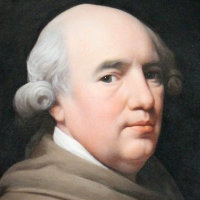 |
George Stubbs, 1724–1806. English painter. Originally self-taught as a painter, Stubbs also pursued studies in anatomy, of humans and later on his own initiative of the horse, publishing an Anatomy of the Horse in 1776. While most of his paintings are portraits of horses commissioned by their owners, Stubbs also did some subjects such as the Lion Attacking a Horse of 1770 which are clearly in the spirit of early Romanticism. |
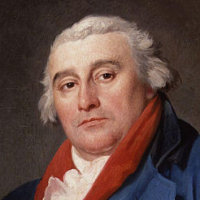 |
Philippe de Loutherbourg, 1740–1812. French-born English painter and designer Born in Strasbourg, he settled in London in 1771, designing theatre sets for Garrick and Sheridan, publishing picuresque views of Britain, and painting large canvases mostly exalting the Sublime. |
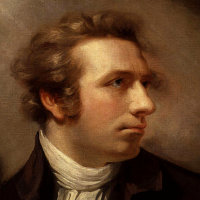 |
Henry Fuseli, 1741–1824. Swiss-born English painter. Born Johann Heinrich Füssli, he was Swiss painter who settled in England and became Professor of Painting at the Royal Academy. His bold hyper-dramatic style had a great influence on younger artists, including William Blake, and his interest in supernatural subjects would make him an important precursor of Romanticism. |
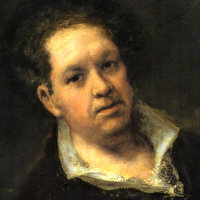 |
Francisco de Goya y Lucientes, 1746–1828. Spanish painter. A slow developer, he began as a somewhat conventional Rococo painter and tapestry designer, but developed into an insightful portraitist, and—after going totally deaf in 1792—a savage social critic as a printmaker, and painter of some of the most terrible events of his time. His series of "black paintings" from the end of his life display a shattering visionary intensity. |
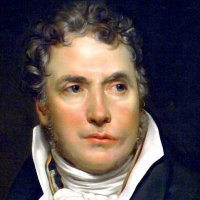 |
Jacques-Louis David, 1748–1825. French painter. The leading Neoclassical artist of his day, David replaced rococo frivolities with stern history paintings with strong moral content. He was a dedicated supporter of the Revolution and politically active as a Deputy. He was imprisoned briefly after the fall of Robespierre, but resurfaced as principal painter to Napoleon. Through his many pupils, he influenced French salon style for a generation. |
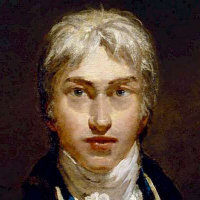 |
Joseph Mallord William Turner, 1775–1851. English painter. Rivaled only by Constable, Turner was the dominant British landscape painter of the first half of the 19th century, he started his career with topographical views intended for engraving, and ended with works whose subjects were dissolved in veils of paint and light. |
 |
Horace Vernet, 1789–1863. French painter. A contemporary and friend of Géricault and Delacroix, he specialized in literary, exotic, and increasingly contemporary subjects, known for their free handling and striking color. |
 |
Théodore Géricault, 1791–1824. French painter. Géricault's monumental Raft of the Medusa (1819) was a seminal work in French art, treating a contemporary political scandal with searing humanity coupled with a monumentality that owes much to Michelangelo. His many studies for this work, including corpses and severed limbs, his portraits of the insane, and above all his numerous paintings of horses, made him a key figure in French Romanticism until his tragic death of a riding accident at the age of 32. |
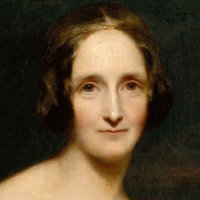 |
Mary Wollstonecraft Shelley, 1797—1851. English novelist. The daughter of the political philosopher William Godwin and the feminist activist Mary Wollstonecraft, Shelley fell in love with the poet Pecy Bysshe Shelley when he was already married and eloped with him to the continent to avoid ostracism at home. She wrote her most famous novel, Frankenstein (1818), in response to a competition with Lord Byron, John Polidori, and her lover during a rainy holiday in Switzerland. |
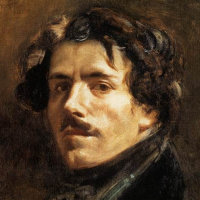 |
Eugène Delacroix, 1798–1863. French painter. The leading French painter of the Romantic movement, he is known for his brilliant Rubensian color and his dramatic compositions. Especially in the first half of his career, these included political themes, such as The Massacre at Chios (1824) and Liberty Leading the People (1830), as well as subjects from Romantic literature. He also visited North Africa, and was constantly fascinated by the exotic. |
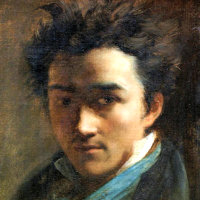 |
Alexandre-Marie Colin, 1798–1875. French painter. A friend and exact contemporary of Delacroix, moved in the circle of Romantic painters of the 1820s, and to a certain extent was one himself, painting mainly historical and genre subjects. |
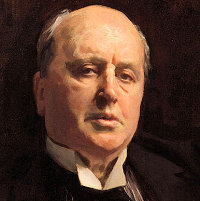 |
Henry James, 1843–1916. American-English novelist. Born in New York, James traveled a lot with his family as a child, and settled in England in 1869. Many of his novels concern American expatriates in Europe, and the later ones especially have been hailed as the bridge to Modernism. His novella The Turn of the Screw (1898) is one of the most influential ghost stories of all time. |
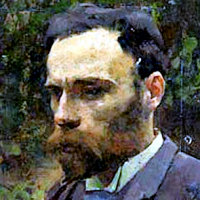 |
John William Waterhouse, 1849–1917. English painter. Beginning in an academic manner, he became drawn to Pre-Raphaelite style and subjects, with illustrations from Shakespeare, Greek myth, and Arthurian legend. |
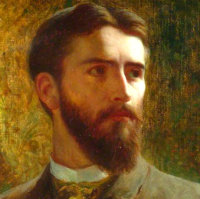 |
Frank Dicksee, 1853–1928. English painter. Sir Francis Bernard Dicksee was the son, brother, and cousin of successful painters. Like his father, he had a particular interest in literary and historical subjects. He became President of the Royal Academy in 1924. |
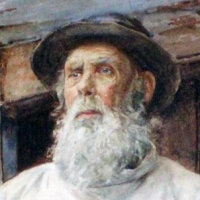 |
Henry Maynell Rheam, 1859–1920. English painter. No information is readily available for this painter. The image at left is a painting by him but not of him. |
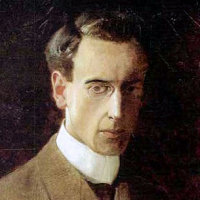 |
Frank Cadogan Cowper, 1877–1958. English painter. An English painter of portraits, historical, and literary subjects, he has been described as "the last of the Pre-Raphaelites." |
